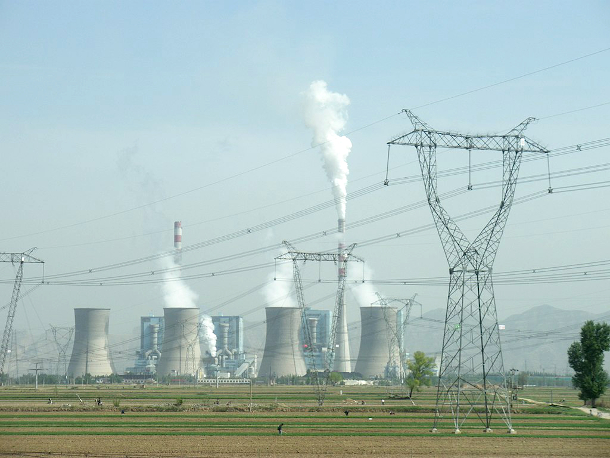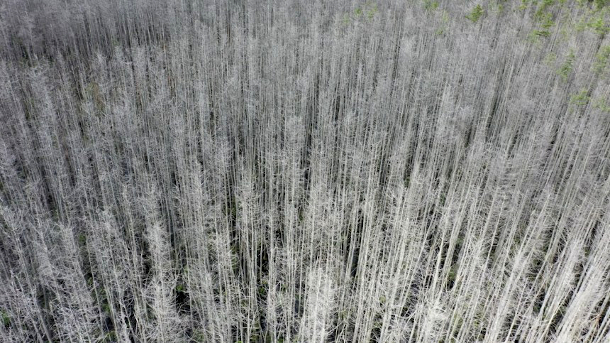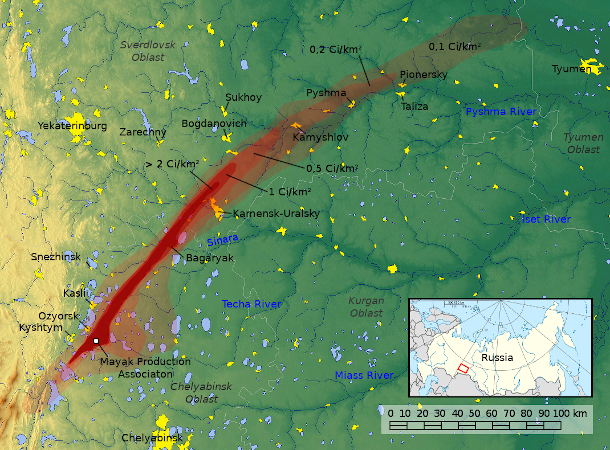Beyond the Headlines
Air Date: Week of October 1, 2021

A coal-fired power plant in Shuozhou, Shanxi, China. (Photo: Kleineolive, Wikimedia Commons, CC BY 3.0)
Environmental Health News Editor Peter Dykstra joins Host Steve Curwood to talk about China’s plans to quit financing coal-fired power plants in other countries. Also, along the U.S. East Coast, sea level rise is creating “ghost forests” of trees killed by saltwater. In the history calendar, they look back to the 1957 Mayak nuclear disaster in the Soviet Union.
Transcript
CURWOOD: It's time now to take a look beyond the headlines with Peter Dykstra. He's an editor with Environmental Health News, that's EHN.org and DailyClimate.org. He's on the line now from Atlanta, Georgia. Hi there, Peter, how are you doing? What have you got for us today?
DYKSTRA: Well, hi, Steve. There's a story coming out in advance of the climate summit happening in little over a month in Scotland starting October 31, where China has told the world that it's going to quit financing coal fired power plants in other countries.
CURWOOD: Well, that's pretty good news. I mean, China has been exporting a lot of coal fired power plants. But on the other hand, they have like over 900 themselves, doesn't sound like they're gonna shut those down, or stop building those at home.
DYKSTRA: Now, China has four times as many coal burning power plants as the next leading nation, which is, of course, the United States. We're talking about the financing of a dozen coal plants in South Africa, other nations in Southeast Asia, Pakistan, South America, I don't think anyone is regarding it as a huge turnaround by China, still the world's largest emitter, with the US and India not too far behind.
CURWOOD: It's nice, though, to see China put something down on the table because before Paris, the US and China got together and really hammered out a lot of the details of a deal, but right now the US and China don't seem to be getting on and seem to be in any kind of mood to develop an agreed upon climate plan. So this could be good news.
DYKSTRA: That's right, but it's past time for us to quit playing two steps forward and one step back on climate.
CURWOOD: Indeed. Hey, what else do you have for us today?
DYKSTRA: Here's a term that will give you the creeps a little bit. And it's happening along the US East Coast, among other places, the phenomenon of ghost forests. These are coastal wetlands, forests, trees, like cedar trees that are dying off as saltwater intrusion reaches into freshwater wetlands and kills the trees, turning them from verdant green, to stark white.

Sea level rise linked to climate change is creating "ghost forests" up and down the U.S. East Coast and elsewhere. (Photo: New Jersey Parks and Forestry, Public Domain)
CURWOOD: And I gather some of these have been seen in your old home state, New Jersey.
DYKSTRA: That's right. Jersey, with all the wetlands and the pine barrens is an unfortunate leader in this environmental setback, but it's happening up and down the coast. And saltwater intrusion isn't just a factor in killing off coastal forests. It's a factor in potentially killing off coastal water supplies. Here in the southeast, along the Georgia sea coast and South Carolina around Jacksonville, Florida, a lot of the drinking water sources are freshwater aquifers along the coast. As saltwater literally gets sucked in and pushed inward by sea level rise, it's going to contaminate those aquifers, putting them out of reach, just as populations along the coast continue to grow.
CURWOOD: That is not good news, Peter. Well, let's look back in history now for a moment. What do you see?

Track of the Eastern Ural Radioactive Trace, the area contaminated by the 1957 Mayak disaster. (Photo: Goran tek-en, Wikimedia Commons, CC BY-SA 4.0)
DYKSTRA: On September 29, 1957, a tank with liquid nuclear waste exploded at a plant called Mayak in the central Soviet Union, hundreds of square miles down wind were contaminated by radiation. Because of the secrecy in the Soviet Union, we don't know how many people were affected or killed. But it's regarded as the third worst nuclear accident in history in terms of an area and population contaminated, behind only Chernobyl and the Fukushima accident in Japan.
CURWOOD: And I remember hearing something about Chelyabinsk. This is the same place, yes, no?
DYKSTRA: It's the same place. So good were the Soviets at keeping secrets about their nuclear work that Chelyabinsk was actually a huge, teeming nuclear city that no one knew about. It was deeply contaminated. And again, we still don't know quite how much, how fully or whether it's still contaminated. But what became known as the Chelyabinsk accident was one of the worst ones we've ever had.
CURWOOD: Let's hope that those kinds of accidents stay in the history books, Peter. Peter Dykstra is an editor with Environmental Health News. That's EHN.org and DailyClimate.org. Thanks so much. We'll talk to you again real soon.
DYKSTRA: All right, Steve, thanks a lot. Talk to you soon.
CURWOOD: And there's more on these stories that the Living on Earth website that's LOE.org.
Links
DW | “Climate Change: China To Exit Coal-Fired Power Abroad”
NBC | “Ghost Forests Creep Up U.S. East Coast”
Learn more about the 1957 Mayak nuclear accident near Chelyabinsk, Russia
Living on Earth wants to hear from you!
Living on Earth
62 Calef Highway, Suite 212
Lee, NH 03861
Telephone: 617-287-4121
E-mail: comments@loe.org
Newsletter [Click here]
Donate to Living on Earth!
Living on Earth is an independent media program and relies entirely on contributions from listeners and institutions supporting public service. Please donate now to preserve an independent environmental voice.
NewsletterLiving on Earth offers a weekly delivery of the show's rundown to your mailbox. Sign up for our newsletter today!
 Sailors For The Sea: Be the change you want to sea.
Sailors For The Sea: Be the change you want to sea.
 The Grantham Foundation for the Protection of the Environment: Committed to protecting and improving the health of the global environment.
The Grantham Foundation for the Protection of the Environment: Committed to protecting and improving the health of the global environment.
 Contribute to Living on Earth and receive, as our gift to you, an archival print of one of Mark Seth Lender's extraordinary wildlife photographs. Follow the link to see Mark's current collection of photographs.
Contribute to Living on Earth and receive, as our gift to you, an archival print of one of Mark Seth Lender's extraordinary wildlife photographs. Follow the link to see Mark's current collection of photographs.
 Buy a signed copy of Mark Seth Lender's book Smeagull the Seagull & support Living on Earth
Buy a signed copy of Mark Seth Lender's book Smeagull the Seagull & support Living on Earth

